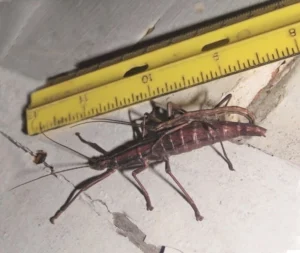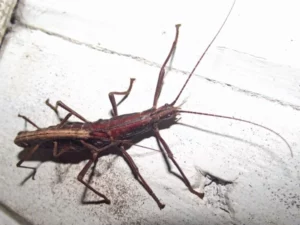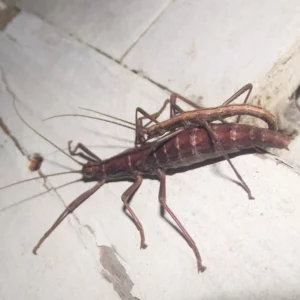Note: All links leave to external sites.
Howdy, BugFans,
In the recent episode about Saddleback caterpillars, the BugLady mentioned that she (rightly or wrongly) associates the South with a larger number of plants and animals that sting, bite, itch, poison, stab, spray, and spit (sorry, folks). Here’s another one.
First of all, we’re not talking about the svelte Northern Walkingstick that graces our landscapes here in God’s Country. The order Phasmida (aka the order Phasmatodea or Phasmatoptera) contains five walkingstick/stick insect families in North America (“Phasma” means phantom or spirit). Northern Walkingsticks are in the family Diapheromeridae, and Northern Two-striped Walkingsticks are in the Striped Walkingstick family Pseudophasmatidae.
Thank You, BugFan Joe, for sending pictures from the Deep South and for submitting them to bugguide.net for a species ID. Here’s what the expert at bugguide said, “The taxonomy of this genus needs to be worked out, but I would lean on these being ferruginea. True A. buprestoides [the Southern Two-striped Walkingstick (STSW)] is supposed to be mostly restricted to Florida and extreme southern GA and AL, and is supposed to have the dorsal stripe much more distinct. But better to leave at genus level for now.” Our knowledge of the lifestyles of the two species has some gaps in it, but they seem to operate similarly.
Anisomorpha means “unequal form,” and the BugLady guesses that refers to the size difference between males and females. There are four species in this New World genus – two north of Mexico – and (like the Saddleback caterpillar) they are famous/notorious for their chemical defense system.
So – the Northern Two-Striped Walkingstick (Anisomorpha ferruginea) (probably) (ferruginea means “rust-colored”). Like many odd-looking critters, it has amassed a bunch of common and regional names – Prairie Alligator, Musk Mare (she’s a Musk Mare; he’s a Musk Stallion), Western Two stripe, Witch’s Horse, Devil’s Darning Needle (dragonflies are given that nickname, too), Witch’s Hose, Stick Bug, Spitting Devil, Devil Rider, and even Scorpion. The names come from its appearance, from its defense strategy, and/or from the piggyback habits of the male (she does not carry her young on her back like a loon or opossum or wolf spider).

NTSWs are found from South Carolina to Alabama, through Texas and Oklahoma, plus Illinois; there are Florida records of NTSWs, but nymphs of the NTSW and the STSW are pretty hard to tell apart (adults can be, too), so those records are considered a little iffy. Females are chunky, tan/brown/rust, and about 2 ½” to 3” long, not counting the antennae, and males are about 1 ½” long. NTSWs have straighter, slimmer legs than STSWs, and STSWs are a little larger, come in three color morphs, and (often) have more distinctive stripes. Insects’ legs (and wings) are attached to the thorax, and in aid of their twiggy disguise, the walkingsticks’ extra-long thorax allows their legs to be spaced out along its length. Many, but not all, species are wingless.
They graze on leaves at night, and they seem to be fond of members of the oak family, but not exclusively. One source said that when numerous, they can damage/defoliate shrubs; one said that they don’t do significant damage; and the Missouri Department of Conservation Field Guide says (rather optimistically) that “Musk mares help to limit the growth of vegetation. Over time, they help develop vigorous strains of plants that are least hindered by their leaf chomping.”
Some birds, reptiles, mice, ants, and spiders may be discouraged by their chemical assaults, but not all of them, and their eggs are eaten on the forest floor.

They spend the winter – sometimes two winters – as eggs. Our Northern Walkingstick drops her eggs carelessly from the treetops, the NTSW deposits them into bark crevices or onto the ground, tucked into leaf litter, and the STSW digs little holes for them. They hatch and the nymphs feed, mostly unnoticed, until they mature in fall and gather in open areas or on buildings or tree bark. Mating can last from several days to several weeks (and they’re probably monogamous), but the male continues to ride piggyback after his reproductive duties are done. It has been suggested that the arrangement serves both of them because two sets of eyes looking for predators are better than one.
They protect themselves with a musky, milky, irritating chemical (anisomorphal) that they produce and spray as a fine mist from a pair of glands in the thorax, just behind the head. They spray with amazing accuracy – they aim for your eyes, and they can project the spray at least a foot. They have the ability to spray from the moment they break out of the egg.
What does it feel like? According to the Texas Entomology website, “The first account of A. buprestoides’ effect on humans was apparently by Stewart (1937), who wrote about an incident in Texas: ‘The victim was observing a pair of Anisomorpha buprestoides …. with his face within two feet of the insects, when he received the discharge in his left eye …. The pain in his left eye was immediately excruciating; being reported to be as severe as if it had been caused by molten lead. Quick, thorough drenching with cool water allayed the burning agony to a dull aching pain. The pain eased considerably within the course of a few hours. Upon awakening the next morning the entire cornea was almost a brilliant scarlet in color and the eye was so sensitive to light and pressure for the next forty-eight hours that the patient was incapacitated for work. Vision was impaired for about five days.’ (Thomas 2003).” Inhaling the chemical is unpleasant, too.
The late, great entomologist Thomas Eisner noted that the STSW “is the source of one of the most noxious defensive secretions known to be produced by an insect.” He prodded and pinched them in the lab and reported that it didn’t take much hassling for the STSW to react, that the insect could activate one or both glands, and that it could direct the spray precisely at the probe that poked it. The sight of a bird closer than eight inches away caused an STSW to spray without waiting for the bird to touch it, but the walkingstick did not react to a waving bundle of feathers or colored cloth. Eisner wrote, “The insect is obviously programmed not to waste its secretion by being unduly ‘trigger happy.’” Some mammals simply outlast the STSW, waiting until it has sprayed about five times and its reservoir is empty (it takes a week or two to generate enough spray to refill a reservoir); a few test rats simply got used to the spray and ate the walkingsticks; and STSWs have been found in bear scat.
About anisomorphal Eisner said that “Anisomorphal is also produced by a mint plant, in which the compound is sealed within tiny capsules embedded in the leaf tissue. The capsules are designed to rupture and release their repellent contents when herbivores bite into the leaves.”
Admire these guys from afar – or wear safety glasses!
The BugLady
